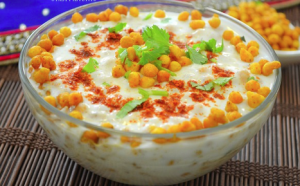Mama’s Punjabi Recipes: Boondi da Raita (Chickpea Drop Yogurt Sauce)

By popular demand, here is a reprint of Mama’s Boondi da Raita recipe, which is a tasty recipe for the summer months to eat with rice biryani, sabzi or simply with paranthas. It is reprinted with some additional information and directions.
Raita can loosely be translated as thinned yogurt dip – though it is not to be eaten as a dip – or a sauce, which it is used as often. The taste depends on the way the yogurt is thinned down, the ingredients and the dishes it complements. Many people use water to thin the yogurt down but all too often it is thinned down so much that is loses its consistency and becomes a gravy, like the type that is poured over kebabs, in Gyros or in pita bread wraps.
Raita is known and eaten all over India and it is important to understand that it is not a condiment but a complement to most Indian foods. It helps to soften the taste – and sometimes the spiciness – of the dish. When it is thicker, it can be served with bhalle (fried lentil balls) and eaten as a separate dish with its own condiments. When it is thinned down a lot with cold water and milk and mixed with spices, it can be drunk like lassi (buttermilk).
So it is important that true raita must have the right consistency and that can be eaten with roti, paranthas or chawal (rice) without running all over the plate but stick to the breads and rice.
Raita is usually made with an ingredient that adds flavor to the otherwise bland taste of plain dahi (yogurt). Depending on the taste desired and the other main dishes on the table, there are different ingredients that can be added. There are many types of raita but two – boondi (chickpea flour drops) and aaloo (potato) – are the most popular.
Boondi raita is very popular in the Punjab and the chief ingredient is the boondi which nowadays can be bought in a packet. In the old days, we would make the boondi by pouring the besan (chickpea flour) masala through a chanani (perforated flat ladle) into a karai (wok) of hot vegetable oil. It would take only a few minutes for the drops to fry and turn yellowish-brown.
Ingredients:
• 500gm saddi dahi (plain yogurt)
• 1-25gm pkt of boondi (chickpea flour drops)
• ½ cup doodh (milk)
• 10 leaves of pudina (mint) (cut in halves)
• Spices to taste: namak (salt), mirch (red pepper)
Directions:
1. Place the boondi in lukewarm water for 10 minutes. This allows the oil to wash out and also the boondi fluffs up.
2. Run through a strainer and let the boondi sit to drain well and cool down for a 5 minutes.
3. Place the dahi in a bowl and stir it thoroughly adding the milk to it. Add the salt and pepper to taste and mix in the mint leaves.
4. Throw in the boondi and mix well but gently so as not to break the boondi.
5. Chill for 10 minutes to let the boondi soak up the yogurt and fluff up and serve.
MAMA’S TIP OF THE WEEK: CLEAN TARNISHED BRASS POTS, ORNAMENTS WITH KETCHUP
If you are enjoy brassware or have a collection of brass items from the Old Country, chances are you haven’t cleaned them in many years and they have become dull and tarnished with a dark film and spots. It can be very disappointing to see them this way, and you can be daunted by the effort it will take to clean them with Brasso polish.
Using Brasso requires a lot of elbow work but there is an easier method. Use a tablespoon of tomato ketchup and a teaspoon of plain salt and smear the brass surface, with your hand. Now scrub with your hand or with a hard sponge. In minutes, the tarnish will disappear and can be easily washed off. Now sprinkle some Comet over the item and scrub some more, then wash again. The brass will become clean and will shine.

Shakuntla Malhotra is a skilled cook of Punjabi dishes made in the old-fashioned style that she learnt as a young woman in her ancestral home in Lyallpur, India (since renamed Faisalabad) before it became part of Pakistan after the Partition in 1947. People have often admired her cooking for its simplicity and taste that comes with each mouthful. Even in her late-eighties, she continues to cook daily and agreed to share her delectable Punjabi recipes for future generations.
